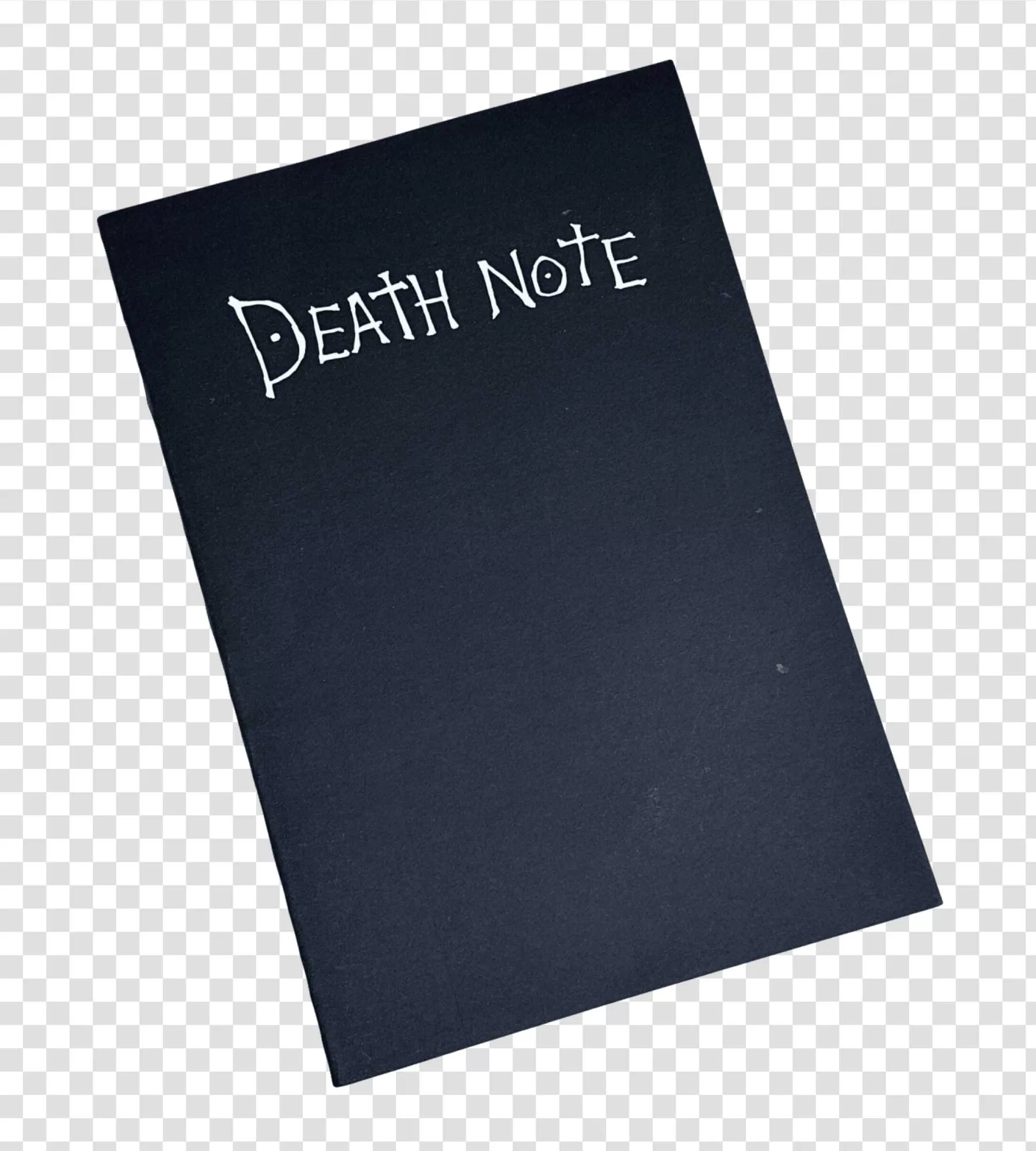Death Note: A Deep Dive into the Phenomenon

The “Death Note” is more than just a title; it’s a cultural touchstone, a gripping narrative that has captivated audiences worldwide through its manga, anime, films, and even a musical. This exploration delves into the “Death Note” phenomenon, examining its impact across various media and its lasting cultural influence. We’ll analyze its literary merit, its various adaptations, and the controversies it sparked, all within the context of a book-focused analysis, exploring the themes, genres, and literary techniques employed in the story.
The Death Note: Object of Intrigue
At the heart of the “Death Note” story lies the titular object itself – a seemingly ordinary black notebook, but one imbued with extraordinary, terrifying power. Its simple appearance, like a standard college notebook, belies its supernatural abilities. The Death Note’s power lies in its ability to kill anyone whose name is written within its pages, provided the writer knows the victim’s face and full name. This simple yet chilling premise forms the backbone of the entire narrative.
The physical description of the Death Note varies depending on the source material. While typically depicted as a simple, black notebook, the Shinigami, the supernatural beings who create and utilize these notebooks, possess the ability to personalize their Death Note’s cover if desired. However, most remain plain black and unadorned. In some interpretations, the notebook’s aesthetics change depending on the era, morphing into a scroll in ancient Japan or a book resembling the Old Testament in medieval Europe. This adaptability underscores the Death Note’s timeless and culturally transmutable nature. The interior, consistently described across all adaptations, resembles a standard ruled school notebook with an infinite number of pages – a detail that emphasizes the relentless nature of death and the seemingly limitless potential for its use. The material composition of the Death Note remains a mystery, existing beyond human understanding of scientific materials, yet still maintaining the tactile familiarity of an everyday object. This contrast between mundane appearance and terrifying power enhances the narrative’s suspense and chilling effect.

The Death Note serves different purposes for Shinigami and humans. For the Shinigami, it is a tool for extending their own lifespans; by killing humans and absorbing their remaining lifespan into their own, the Shinigami avert their own mortality. This highlights the selfish nature of some of the supernatural entities and their inherent self-preservation instincts. Human users, on the other hand, don’t gain immortality; instead, they become pawns of fate, trapped in a deadly game of morality, justice, and power.
The series features several Death Notes. Sidoh’s Death Note, the first notebook encountered, passes through several hands, including Light Yagami, the story’s protagonist, and eventually back to its owner, Sidoh. Gelus’s Death Note, obtained by Misa Amane, also becomes a crucial plot device, affecting various characters and their interactions. Rem’s Death Note played a key role in L’s death. Ryuk, the Shinigami who initially introduced the Death Note to Light Yagami, retains ownership of his notebook throughout the series. The introduction of a new Death Note, Midora’s notebook, in the sequel “a-Kira” illustrates the enduring theme of the Death Note’s potent influence.

The Rules of the Death Note: A System of Control
The Death Note’s power is not absolute; its use is governed by a set of rules, meticulously detailed in the “Death Note 13: How to Read” guidebook. These rules, initially presented by Ryuk, the Shinigami who drops the notebook into the human world, add layers of complexity and strategic depth to the narrative. The core rule—that the human whose name is written in the notebook will die—is straightforward, yet the supplementary rules introduce nuances. The necessity of knowing the victim’s face to prevent accidental deaths, the limitation on misspellings (four incorrect spellings nullify the effect), the stipulation that simultaneous entries within a certain timeframe are ineffective, and the time limit for specifying the cause and method of death all contribute to the strategic cat-and-mouse game between Light Yagami and L.

The rules regarding cause of death further amplify the strategic elements. If the cause of death is not specified, the victim dies of a heart attack within 40 seconds. However, the writer can dictate a specific cause of death and even manipulate the time of death within specific constraints. The condition of death must be physically possible, or realistically achievable for the victim. This adds another layer of intricacy to the power of the Death Note; it’s not a simple tool of instant death but a sophisticated instrument that requires planning, foresight, and knowledge of the target’s circumstances. The inclusion of these rules in the “Death Note 13: How to Read” guidebook highlights the necessity of strategy and knowledge for effective use of the Death Note, setting the stage for intricate plot twists and thrilling suspense. The rules also showcase the limitations of absolute power, emphasizing the fact that even supernatural abilities are confined by constraints.
Genres and Themes: A Blend of Mystery and Morality
“Death Note” masterfully blends genres, primarily residing within the realms of mystery, psychological thriller, and supernatural thriller. The mystery lies in the unraveling of Kira’s identity and the constant cat-and-mouse game between Light Yagami and L. The psychological thriller element manifests in the exploration of Light’s descent into darkness, his manipulation of others, and the internal conflicts that plague him. The supernatural elements introduced by the Death Note and the Shinigami, Ryuk and Rem, create a unique atmosphere, setting the stage for a narrative that is both thought-provoking and thrilling.
The series delves into complex themes centered around morality, justice, and the nature of good and evil. Light Yagami, a brilliant student, believes he is creating a better world by eradicating criminals, but his methods are inherently brutal and morally questionable. L, the enigmatic detective who hunts Light, represents a more traditional, legal approach to justice. The conflict between their ideologies drives the plot forward and forces the audience to grapple with the ambiguities of morality and the slippery slope between justice and vengeance. The Death Note’s existence itself raises questions about absolute power and its corrupting influence, further highlighting the series’ moral complexities.
The Death Note Across Media: Adaptations and Cultural Impact
The success of “Death Note” transcends its initial manga form; its story has been adapted into an anime series, light novels, live-action films (both Japanese and American), and even a musical. Each adaptation interprets the source material with its own style and perspective. The anime, produced by Madhouse, maintains the core narrative but fleshes out character motivations and explores psychological depths more extensively. The live-action films, while adhering to the basic plot, offer variations in character development and pacing. The American adaptation, though criticized for deviating from the source material, showcases the global interest and adaptability of the story. These multiple adaptations underscore the enduring appeal of the narrative’s core themes and the power of its central conflict. The diversity of adaptations reflects the flexibility of the Death Note concept; it can be reinterpreted and refreshed across different mediums and cultural contexts.
The “Death Note” has had a significant cultural impact. Its popularity has led to various spin-off products, including merchandise and video games. The series’ global reach is a testament to its universal appeal, as audiences worldwide connect with its central themes of morality, justice, and the consequences of unchecked power. This impact, however, has also led to controversies. Numerous incidents of individuals mimicking the Death Note, creating their own versions to list names of those they wish harm upon, demonstrate both the impact of the story and its potential for negative influence. It serves as a reminder of the responsibility that accompanies storytelling and the need for critical engagement with media, particularly material that explores themes of violence and death. The various adaptations of the series have also contributed to its continued cultural resonance, allowing new generations to discover and grapple with the narrative’s profound themes.
The Legacy of “Death Note”: A Continuing Conversation
The enduring popularity of “Death Note” stems from its skillful blend of genres, complex characters, and exploration of profound moral questions. The Death Note itself serves as a potent symbol of the corrupting influence of absolute power and the gray areas of justice. Light Yagami’s journey, from a seemingly well-intentioned vigilante to a ruthless and manipulative killer, is both chilling and captivating. L’s pursuit of justice, using unconventional methods, prompts the audience to question the boundaries of the law. The enduring resonance of “Death Note” is rooted in these elements, fostering ongoing conversations about morality, ethics, and the complex choices we face in striving for justice. The series has not only left a significant mark on the anime and manga landscape but has also infiltrated mainstream popular culture, proving its enduring relevance and complex themes. The ongoing discussions and reinterpretations of “Death Note” ensure its continued place as a significant cultural phenomenon.